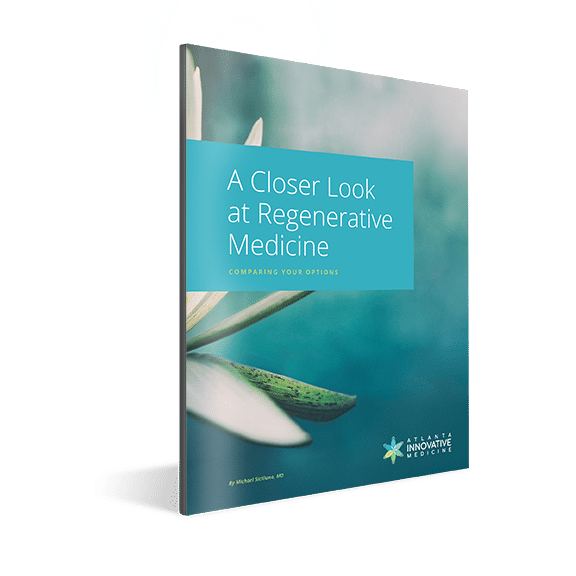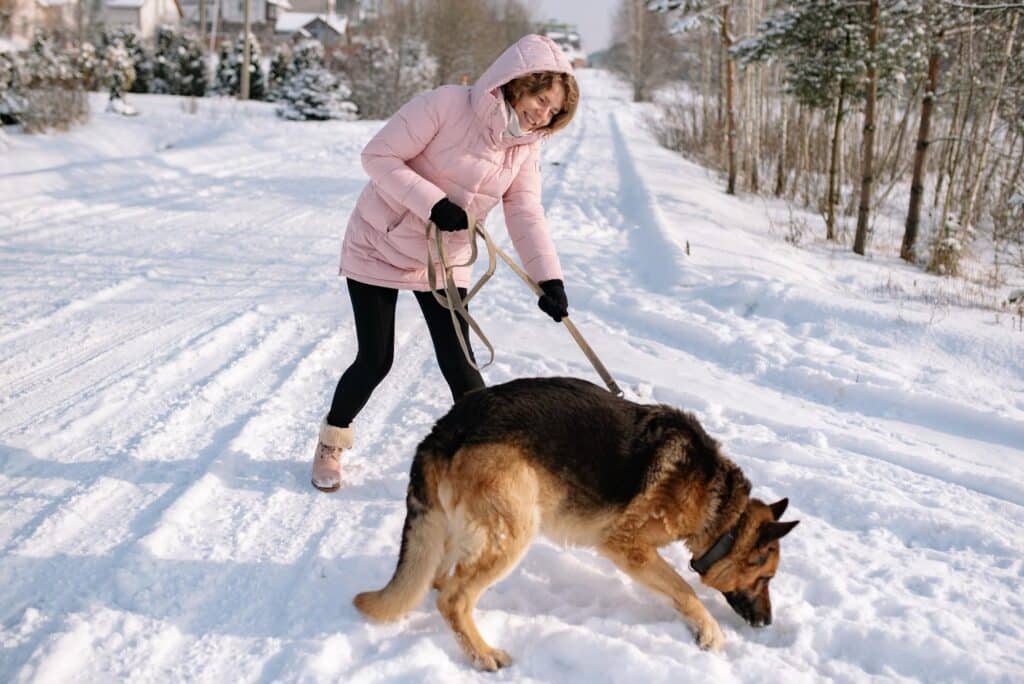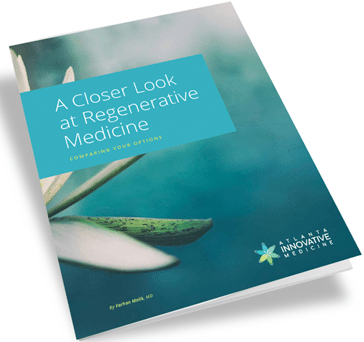By Farhan Malik, MD
Atlanta Innovative Medicine
Winter is fast-approaching and that means the return of cold weather sports, winter-exclusive activities, and, less exciting, the risk of cold weather injuries. From snowboarding and icy winter jogs to chilly jaunts to the store, cold weather brings its own set of risks—and not just icy fall risks but the less obvious physiological risks of cold temperatures, too.
In this article, we’ll explore these risk factors for cold weather injuries, as well as prevention strategies to help you stay well and protect your body as you set out on your favorite winter activities.

Understanding Cold Weather Injuries
The most evident risk for cold weather injuries is from slips and falls due to icy conditions. This is especially relevant when it comes to outdoor exercise and high-intensity activities that demand agility, balance, and precise movements.
When you slip and fall on ice, the impact can be much harsher compared to a fall on a softer surface, leading to more severe cold weather injuries and increasing the likelihood of sprains, strains, and fractures.
While this is a legitimate risk factor that warrants extra precaution, icy surfaces just scratch the surface of risk factors for cold weather injuries.
Outdoor Winter Strains & Sprains
Do you ever feel like you have freezing muscles? Well, they really are colder! To maintain its core temperature in cold weather, the body undergoes vasoconstriction, the tightening of muscles to shrink blood vessels and reduce blood flow to the extremities, reserving heat for the vital organs.
This muscle tightness and reduced blood flow limits your flexibility and range of motion, making it much easier to over-stretch or tear the tissues, resulting in sprains or strains.

How Does Cold Temperature Affect Muscle Contraction?
Think of your muscles and tendons as rubber bands. When they are warm and pliable, they can stretch and move with ease, allowing for a full range of motion without the risk of injury. However, in cold weather, these “rubber bands” become tighter, making them less capable of stretching without tearing. Especially during exercise that involves rapid movements or sudden changes in direction, this reduced elasticity increases the likelihood of winter injuries.
Additionally, cold weather has an impact on your body’s basal metabolic rate, meaning your body has to produce more energy in cold conditions to maintain its core temperature and vital function. This extra energy allocation takes away from your muscles, making them tire more quickly and perform less effectively.
When exercising, this decreased muscle performance can easily lead to poor form, like awkward movements or overextension. Compounded by limited flexibility, even small slip-ups can lead to strains, sprains, and other cold weather injuries—especially in icy conditions.
Overexertion & Dehydration
In cold weather, the body is constantly working to maintain a consistent internal temperature. When exercising, this extra effort can lead to overexertion—excessive physical effort that surpasses your body’s capacity to recover and adapt to the strain.

One possible effect of overexertion is dehydration, when excess fluid loss from increased sweat and respiration is not sufficiently replenished. Failing to rehydrate can be especially easy to do when cold weather makes us feel less thirsty.

Subscribe for Expert Insights and Our Ebook
A Closer Look at Regenerative Medicine: Comparing Your Options Learn about treatment options like Platelet Rich Plasma (PRP), Prolozone Therapy, and Stem Cell Therapy.
Hypothermia & Frostbite
Hypothermia is a potentially life-threatening condition that occurs when your body loses heat faster than it can produce it, causing a dangerously low body temperature which affects the function of your vital organs.
This happens when the body is exposed to cold weather for extended periods without sufficient protection. While it is most common in severe conditions, hypothermia can also happen in above-freezing temperatures, especially if the body is exposed to moisture, which is particularly relevant in the humid environment in and around Atlanta. Symptoms of hypothermia include shivering, confusion, exhaustion, and slurred speech.

Frostbite occurs when the skin and underlying tissues freeze due to exposure to extreme cold. It typically occurs in the extremities, like the fingers, toes, and ears, where constricted blood vessels result in insufficient blood flow, lost heat, and the formation of ice crystals. Frostbite typically causes numbness, tingling, and pale or hardened skin; and if severe or left unaddressed, it can cause lasting tissue damage.
Chilblains
Chilblains are discolored patches or blisters that form on the skin when it’s been over-exposed to cold temperatures. Like frostbite, these blisters form on the extremities where poor circulation results in lost heat. However unlike frostbite, chilblains are minor irritations that only affect the outer skin and that typically resolve on their own within a few weeks.
Though less severe than frostbite, chilblains can be quite troublesome—especially when they form on the feet and lead to limping. This misaligned walking can cause muscular imbalances and disrupt your body’s natural alignment, overtime leading to aches and pains throughout your musculoskeletal system in areas like your back, knees, and hips.
Does Cold Weather Affect Injuries?
In addition to the heightened risk of cold weather injuries themselves, cold weather can also exacerbate musculoskeletal pain from existing injuries or chronic conditions. Because the cold can cause muscles to tense up and joints to become stiffer, movement can become painful for individuals already dealing with musculoskeletal damage.
Preparing Your Body
While you can’t (and don’t want to) avoid your body’s natural physiological response to cold temperatures, you can build resilience to the cold, mitigating side effects and reducing the risk of cold weather injuries. The best way to prepare your body for cold weather is to build strength, flexibility, and overall fitness.
Regular exercise contributes to improved cardiovascular health and more efficient blood circulation, helping keep your extremities warm. Regular stretching can improve your base flexibility and counteract the stiffness that cold temperatures bring. Plus, when you are physically fit, you tend to have a higher basal metabolic rate which allows you to safely endure cold temperatures for longer.
Of course, every body has cold weather limits, and even when you are physically fit, it’s important to take precautions to avoid cold weather injuries.

Cold Weather Injury Prevention Strategies
Increase Caloric Intake
When your body has to work extra hard just to stay warm, it burns more calories. To combat nutritional deficiency and fatigue, it’s important to increase your calorie intake accordingly, especially in preparation for high-intensity exercise or long days out in the cold. Consuming nutrient-dense foods and high-energy snacks helps your body generate the heat needed to stay warm and energized, reducing the risk of cold weather injuries.
Avoid Alcohol & Caffeine
Alcohol and caffeine can increase vasoconstriction, potentially limiting blood flow to your extremities. When planning to spend an extended period in cold temperatures, like a full day at the ski resort, it’s best to limit or avoid these substances as they can contribute to poor blood circulation. Opt for warm, non-alcoholic beverages to keep your body well-regulated and your circulation flowing smoothly.
Choose Appropriate Clothing
Whether sitting still or exercising, choosing the right clothing is crucial to preventing cold weather injuries. This means choosing clothes that prioritize a warm core and optimal blood flow.
Avoid tight-fitting garments, wear a hat and gloves to minimize heat loss, and opt for clothing that enables a comfortable range of motion while still providing insulation and protection. Dressing in layers is often the best way to do this, choosing heat-retaining materials for the inner layers and materials that are water-resistant, windproof, and breathable for the outer layers.

Warm Up
Spend extra time warming up, and prioritize dynamic exercises such as light jogging, jumping jacks, or dynamic stretches to gradually elevate your heart rate and prepare your body for the demands of your activity. Engaging in a thorough warm-up routine helps increase blood flow to the muscles to help combat stiffness and improve mobility, making it an important safeguard against cold weather injuries.
Staying Safe During Outdoor Activities
Preventing cold weather injuries relies heavily on proper preparation and basic injury prevention strategies, but it’s also important that you know how to respond to physiological shifts and unexpected emergencies.
Maintain Caloric Intake and Hydration Levels
Maintaining caloric intake isn’t just about consuming a nutritional meal at the start of your day but also replenishing your body throughout your activities. At the turn of the season, it’s easy to be surprised by how many calories your body needs to maintain energy, so it’s a good idea to bring snacks with you on long excursions.
Additionally, if you’ll be out on the slopes or on a remote trail run, it’s smart to keep an extra store of high-calorie foods on hand to sustain energy in the case of injury and immobilization. You should also be extra intentional about drinking water since your body might not give you the same signals of thirst in cold weather.

Keep Clothes Dry
In cold temperatures, moisture significantly increases your risk of hypothermia, frostbite, and chilblains, so it’s important to avoid excess sweat as much as possible. Adjust your clothing layers as your internal body temperature changes to avoid overheating. If your clothing does become wet, change into dry garments as soon as possible to maintain warmth and avoid cold weather injuries.
Watch for Signs of Frostbite and Hypothermia
During extended outdoor activities in the cold—below freezing or not—it’s vital to be vigilant for signs of frostbite and hypothermia. Frostbite is most common in the fingers, toes, nose, and ears. If you notice the skin tingling, turning pale, or becoming hard or waxy, remove yourself from the cold and warm your hands. You should also remove yourself from the cold if you begin shivering; this is your body’s attempt to warm up its chilled core and protect its vital organs—don’t wait for hypothermia to set in.
Avoid Rapid Movements
Avoid rapid movements like high-intensity interval workouts when it’s very cold. Pay close attention to your form, whether jogging, skiing, or skating, to minimize the predisposed risk of sprains, strains, and falls.
Post-Activity Recovery
Taking steps to support your body’s complete recovery is important after strenuous activity in any environment, but the extra demands of cold weather can make these practices especially beneficial.
Cool Down: Yes, even in the cold, cooling down is necessary! Cool-down stretches help maintain blood flow throughout your body, aiding the gradual return of your heart rate to its baseline, preventing post-workout soreness, and supporting cardiovascular health.
Replenish Fluids: Post-activity recovery should always begin with adequate hydration to restore lost minerals and nutrients. In cases of dehydration, intravenous (IV) therapy can offer rapid replenishment and restoration of essential nutrients.

Eat a Balanced Meal: With or without cold weather injuries, your muscles need to recover and rebuild after high activity. Considering the increased caloric expenditure in cold temperatures, it’s essential to refuel your body with plenty of nutrients to support muscle repair and energy replenishment.
Seeking Professional Help
While taking precautions like these can significantly reduce the risk of cold weather injuries, it’s important to acknowledge that sustaining an injury in cold conditions is a real possibility.
Cold weather can be especially unforgiving on your musculoskeletal system, and if you find yourself injured or experiencing unidentifiable pain this winter, there are nonsurgical orthopedic methods that can help you safely and naturally return to good health and thrive through the season.
Physical Therapy: This is often the best place to start when it comes to treating cold weather injuries. Just like strengthening your body is the best mode of injury prevention, regaining strength and flexibility through targeted physical therapy is one of the best ways to recover from injury.
Chiropractic Care: Imbalanced movement from pain—whether it’s fall-related soreness or a cold-weather blister—can cause pain that just keeps growing and becoming harder and harder to identify. Chiropractic care provides the realignment necessary for musculoskeletal health and recovery.
Sarapin Injections: Especially relevant to cold-weather injuries, muscle tightness, spasming, and inflammation can prolong pain and worsen the injury. Sarapin injections help restore blood flow to the injured area, relaxing the muscle to both alleviate pain and support the body’s healing process.
Regenerative Therapies: When more intervention is needed to repair cold weather injuries, like tears in the ligaments and tendons, regenerative therapies offer promising, nonsurgical solutions. Stem cell therapy, platelet-rich plasma, Prolozone, hemozone, and prolotherapy are some of the most advanced and effective therapies available, offering a range of regenerative effects to stimulate the body’s natural healing process and restore damaged tissues.
Integrative Orthopedic Approach: At Atlanta Innovative Medicine, we offer all of these therapies and more, delivering a highly tailored, integrative approach to recovery that both relieves the symptoms and heals cold weather injuries at their core.
Understanding how to protect your body from cold weather injuries is vital to managing your health and wellbeing and maintaining the pain-free life you deserve.
Winter offers some of the most beautiful times of year and best recreational activities, and the risks of cold weather don’t have to win out. By taking preventive measures seriously, investing time in post-activity recovery, and responding to injuries quickly with nonsurgical orthopedic interventions, you can navigate the winter months safely and naturally.
Whether you’re in need of orthopedic treatment or are looking to proactively strengthen your muscles and joints for a safer, healthier winter, Atlanta Innovative Medicine can help.
Call 770.416.9995 or click the button below to schedule your appointment with AIM today.
Quizzes
Are you a candidate for Regenerative Medicine?
Regenerative medicine can be an effective therapy and treatment option for lasting pain relief for a variety of conditions like osteoarthritis of the knee, hip or shoulder; ACL or meniscus tears; tennis or golfer’s elbow; chronic neck and back pain; and more.
Is it right for you and your condition? Take 1 minute to answer a few “yes or no” questions that help to assess if you might be a candidate for PRP, stem cell or other nonsurgical regenerative treatments.
Are You a Stem Cell Candidate for Your Joint or Spine Damage?
Are you a candidate for Platelet Rich Plasma (PRP) Therapy?
Do I have nonsurgical options for my injured or aging joints?
Take the Pain Medications Risk Quiz

Regenerative Medicine.
Reimagined
- Advanced hybrid therapies, including Mesenchymal Stem Cell therapy combined with different mechanisms of action that synergistically come together to support ultimate healing
- More powerful PRP that’s customized, amplified and personalized
- Therapies delivered by an experienced, compassionate team comprised of multidisciplinary experts in traditional and alternative medicine working as your team: Medical Doctors, Nurse Practitioners, Physiotherapists and Chiropractors
- Advanced training through the American Academy of Orthopedic Medicine, the American Osteopathic Association of Prolotherapy Regenerative Medicine, and more
All content of this page is for informational purposes only and is not intended to serve as a substitute for the consultation, diagnosis, and/or medical treatment of a qualified physician or healthcare provider. Individual results may vary. Your medical professional can explain all the risks and potential benefits of any therapy based on your specific circumstances. At this time regenerative therapies are not FDA approved. Neither Atlanta Innovative Medicine nor its physician affiliates promise regenerative therapies as a cure for any condition, disease, or injury.
Other Atlanta Areas We Service:
© 2024 Atlanta Innovative Medicine, LLC. All Rights Reserved. AIM Scholarship Opportunity








